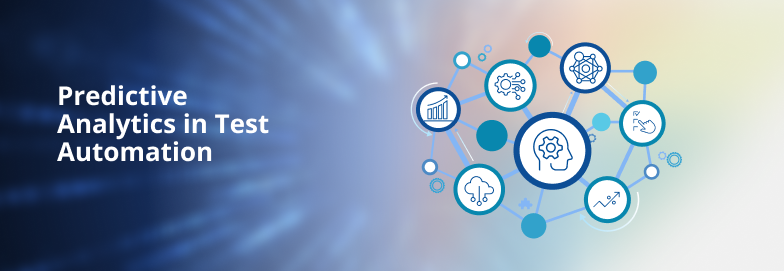Predictive analytics is the use of historical data and statistics to predict future outcomes. It combines machine learning (ML), data analysis, artificial intelligence, and data models to identify patterns that forecast future outcomes. Companies use historical and present data to anticipate trends and behaviors seconds, days, or years in advance with great accuracy.
Predictive analytics can be used in any industry, from healthcare to fraud detection, from marketing to investments, and, of course, software development and software testing. In test automation, predictive analytics use data from code repositories, defect logs, user input, testing tools, and production settings to build models that predict the software quality and results using regression, classification, clustering, anomaly detection, and natural language processing techniques. These models provide actionable insights to QA teams by emphasizing priority features for testing, main test cases, urgent fixes, and important code reviews.
Predictive Analytics Models
There are multiple predictive analytics models, based on the type of data used, the business goals, and how complex the relationship between the variables is. Some of the most notable models are:
- Classification model: This a basic and commonly used model that provides simple answers to yes or no questions. It uses past data to produce an extensive assessment of a request. Companies use this model because they can adapt it to include new or updated data when creating a response.
- Clustering model: This model splits data into categories based on certain characteristics. It then takes the data from each group to provide large-scale results for each cluster. This model uses two forms of clustering. With hard clustering, data is classified by evaluating whether the points belong to a specific cluster. As opposed to hard clustering, soft clustering provides a probability for each one.
- Outliers model: The outliers model detects atypical data in a dataset. It can examine specific occurrences of unusual data or their relationships to other classes.
- Decision tree: an algorithm that arranges data sets into a tree-like structure to show the probable results of various options. This model divides the options into branches and lists potential outcomes beneath each decision. Testers can use this to identify the most significant variables in a given dataset.
- Time series model: This model predicts possible outcomes by analyzing past data points at repeated intervals. In software testing, it can be used to estimate test execution time, resource use, and failure rates.
Benefits of Predictive Analytics in Test Automation
Some of the most important benefits of using predictive analytics in software testing, especially in test automation, are:
- Early defect detection and increased test coverage: Using the data from previously discovered bugs and historical test runs, you can predict not only which areas can cluster more defects but also the more probable ones. This way, you can adapt the automated tests to better cover risky areas or certain non-functional aspects.
- Improved user experience: Predictive analytics can help to analyze users’ behavior. By better understanding how the end-users work with the application, you can adapt the test scripts to focus more on the most common areas and make sure they work as expected.
- Predictive performance monitoring: Real-time data from the production environment suggests software performance, availability, and reliability, notifying QA teams of any discrepancies or problems. Predictive analytics can also use data from previous test automation executions to predict how long the test suites will take to execute and what results to expect.
- Cost reduction: Early bug detention, as well as better coverage, can help you reduce costs in software testing. Build features like defect density, code complexity, and test case execution history, choose appropriate modeling techniques, use machine learning algorithms to prioritize test cases, and implement data integration and automated reporting for real-time insights.
- Improved release control: Predictive analytics allows you to quickly anticipate possible risks connected with scheduled releases, and predict the right time to release to market. Testers identify their resource requirements, and analytics ensure suitable allocation.
Data Types Used for Predictive Analytics Models in Test Automation
Any machine learning model is as good as the data it uses. So, if you want accurate predictive analytics for your test automation project, you have to make sure that you use not only enough data but also relevant data. Many types of data can be useful in test automation, but you can adapt them to your needs. Among the most common, we can count:
- Defect data: Collect data related to previous bugs and issues. Using this data, predictive analytics can better anticipate where defects will be found. Use this data to create test scripts that cover the areas more prone to defects.
- Test-related data: This data can be related to the time it takes to run the test suite, the defect ratio, and the test results. This data can help with predicting future results, possible defects, and test execution time.
- Application data: This includes user interaction data, error logs, performance monitoring data, and user feedback. Predictive analytics techniques use this data for regression analysis, time series analysis, and predicting user engagement metrics and application response time.
- Development data: Collecting development data from various stages of the software development lifecycle can help identify code quality issues and areas for improvement. This data can be collected from sources like version control systems, code quality analysis tools, and defects.
Final Thoughts
Predictive analytics in software testing and in test automation is a technique that can help predict future testing outcomes. Such outcomes can mean where in the application under test it is more probable to find new defects, how to increase test coverage to test the riskier features, the expected pass/fail ratio of test cases, and so on. These predictions can help improve the test automation process, improving in turn the user experience, release processes, and overall testing efforts.



